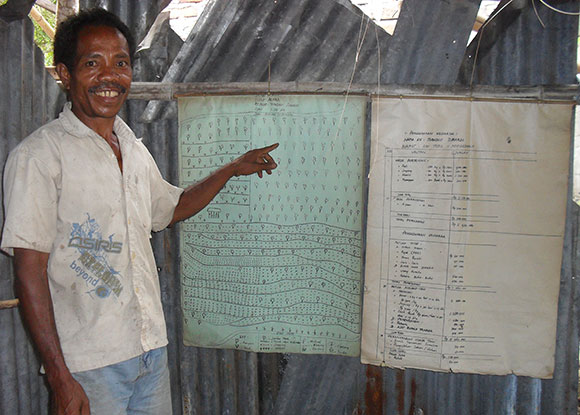The Capacity Building Programme for Poverty Reduction and Livelihood Improvement

World Neighbors (WN) and Yayasan Mitra Tani Mandiri Flores (YMTM F) have colaborated to implement the Capacity Building Programme for Poverty Reduction and Livelihood Improvement in Nagekeo District, funded by the Australian Government through the Australia Nusa Tenggara Assistance for Regional Autonomy (ANTARA)-AusAID programme.. Starting to commence in November 2007 , the 3 year programme was organized in 20 villages, spreading out in four districts of Nagekeo. The programme had the following main objectives.
- To increase corn production.
- To increase the income of poor and very poor families.
- To improve market access and value added of commodity marketing of candle nuts and cashew nuts.
The programme had several main components, namely
- Land and Water Conservation, Management of food crops and long aged trees
- Strengthening UBSP groups and cooperatives.
- Strengthening access to finance in the form of Matching Grant loans.
- Development of entrepreneurship.
- Post-harvest and Collective marketing
What We Have Done
During November 2010 to Desember 2011, Circle Indonesia conducted evaluation of the programme, whose executive summary of the report can be downloaded through the link in sidebar. The variables evaluated were the programme’s outreach, relevance, effectiveness, efficiency, cost-benefit, feasibility, impact, sustainability and replication and scaling up. In general, the evaluation used qualitative approach in its data collection process as well as in its analysis on the programme.
Data collection had been carried out more through Focus Group Discussions (FGDs) and in-depth interviews. However, the evaluation was supported by reviews and calculation of various achievement and economic impacts of the programme of which data profile was quantitative. It also made use the results of end line surveys that had been done separately by using quantitative methods.
FGDs were done in nine villages, of which each involved between 10-25 representatives of village administration, farmers and cattle breeder groups, crafters and other groups. Interviews were carried out with key informants, among others administrators of farmers association and the union of farmers association, farmers groups’ members, administrators of people’s commodity, administrators of Wira Mandiri Cooperatives, village administrators, district administrators, officials of the local House of Representatives and officials of related agencies at the regency level. All findings were represented in a validation forum that involved manager and field staff of the programme.
Recent Posts
- In Your Hands: One Earth for All
- CIRCLE Climate Discussion #2: City Adaptation Efforts in the Global Era Boiling – Delves into Climate Phenomena and Climate Adaptation Methods in the Urban Sphere.
- ”Hybridity”, From Photobook to Documentary Film: A Presentation of Visual Works that Explore Environmental Issues through Various Landscapes of Sense
- CIRCLE Climate Discussion #1: Mapping and Enriching Our Climate Dictionary for Productive Climate Discourse
- Regional Community Consolidation in Yogyakarta in Welcoming the Global Power Up Action: Transition to Solutions
Recent Comments
Archives
- January 2024
- December 2023
- November 2023
- October 2023
- August 2023
- June 2023
- May 2023
- March 2023
- October 2022
- September 2022
- March 2022
- February 2022
- July 2021
- December 2020
- July 2020
- June 2020
- May 2020
- December 2019
- November 2019
- August 2019
- July 2019
- May 2019
- April 2019
- January 2019
- September 2018
- August 2018
- July 2018
- January 2018
- November 2017
- October 2017
- September 2017
- August 2017
- July 2017
- June 2017
- May 2017
- April 2017
- March 2017
- December 2016
- November 2016
- October 2016
- July 2016
- June 2016
- April 2016
- January 2016
- December 2015
- September 2015
- July 2015
- May 2015
- January 2015
- December 2014
- August 2014
- April 2014
- March 2014
- February 2014
- January 2014
- December 2013
- November 2013
- October 2013
- September 2013
